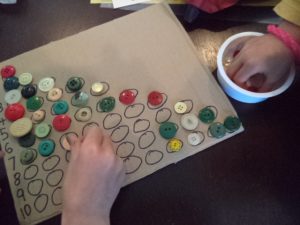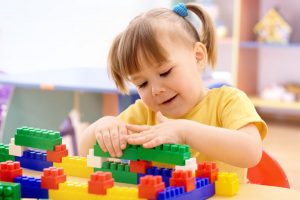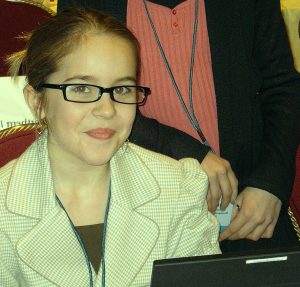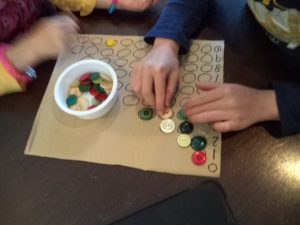Make the day count with this simple transportation counting activity that also helps to develop number sense. These are two early math skills for kids.
In urban areas, there are lots of red, yellow, and green traffic lights. You can make a traffic light counting board with a piece of paper or cardboard. Down the left side, print the numbers from 1 to 5 or for kids that are keen about numbers from 0 to 10. Across the rows, draw the appropriate number of circles for each number. Zero has no circles, one has 1 circle, etc.
To make the traffic lights, for kids beyond the everything-in-the-mouth stage, you can use red, yellow, and green buttons. Or you can use something that kids can eat, such as dried cranberries for the red and mini-Ritz crackers for the yellow. Green is a little trickier, maybe frozen green peas? We looked through our button supplies and found a dishful.
Big Sister counted and filled the circles, going in a line from left to right. Little Sister filled in the circles at the bottom corner. While Big Sister could tell the numbers when she looked at them, Little Sister had to count down from zero until she got to the name.
Counting is much more than just knowing the name of the numbers and how to say them in order. Counting means understanding the relationship between numbers and objects. Each number going up means one more object.
Number sense is an awareness of how many items for each number. For instance, two has one thing and another thing. That’s all. Two isn’t lots, it’s a small number. For kids, 10 is really lots. Some kids might notice how the number of circles in this transportation counting activity and board get bigger like stairs.

As with so many other skills, kids develop accurate counting and number sense from play experiences and everyday opportunities. Do kids need to know how to count to 10 before kindergarten? What they need is to have some familiarity with numbers so numbers do not feel strange and bewildering. This happens by such ordinary activities as counting, talking about numbers, noticing them in the neighborhood, and using them in play activities. What do you do to make your day count?
In the following article, by blogger Jenni B of DearMum, there are more ideas for early math fun.
How to Incorporate Math throughout the Day with Your Toddler

If you asked any kid, no matter how old, what their least favorite subject in school is, the answer is most likely going to be mathematics.
Frankly, who can blame them? Even as adults, many of us still hate having to do anything math related, which is unfortunate since mathematics is one of the most important subjects that can shape our future. Study after study, researchers have shown that kindergarteners with elementary level math skills demonstrated better academic performance than the children that excelled in other areas.
While there are a myriad of mathematical art projects that combine creativity with systemic learning at elementary levels, the skills cultivated early on will set your children up for a future academic career. This doesn’t necessarily mean hiring a math tutor before they’re old enough for school, as there are plenty of ways to teach math throughout the day, whether you’re out shopping or simply having some playtime with the kids, without making it appear as a structured math lesson.
At the grocery store
Working with prices may be too advanced for children at a very young age, but you can improve their skills in counting numbers by helping you pick out vegetables, eggs, and any other items that can be selected in multiples. Have your kids say the numbers out loud as they pick out the food. You may even ask them to add or subtract items to get a certain total.
During playtime
Many have forgotten the importance of playtime as parents fill their kids days with sports, piano lessons and dance classes. Although there is no defined structure for playtime, this is when your kid develops a foundation for all skills learned in later years. There are loads of mathematical concepts to learn with toys and games. Prime examples include puzzles that develop spatial skills, play money that improves counting skills, and building blocks that introduce geometry skills. Simple number board games designed like Snakes and Ladders are also helpful for preschoolers, as the Phi Delta Kappan Common Core explains, “It provides multiple cues to both order of numbers and numbers’ magnitudes or how big and small numbers are in relation to one another.”
In the kitchen
An effortless way to build early math skills in our young ones, having your kids in the kitchen with you will help them understand basic math and science concepts. The main thing you as the adult need to keep in mind is using kid-friendly recipes, ones with uncomplicated measurements and ideally can be accomplished on their own (with parental supervision, of course). As they grow older, you can also teach them about time and temperature.
 Author Bio: DearMum/Jenni B
Author Bio: DearMum/Jenni B
DearMum is an auntie of two preschoolers that love to bake cookies with her and go on grocery trips with her. With all the time she spends with her children, she tries to incorporate learning with all the kid’s activities. Watch out for her own blog soon!

